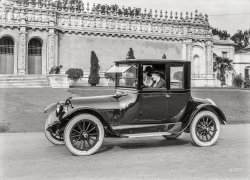
MAY CONTAIN NUTS

Search Shorpy
SHORPY ART

Framed or unframed, desk size to sofa size, printed by us in Arizona and Alabama since 2007. Explore now.
Join and Share
Ad-Free Shorpy
Shorpy is funded by you. Patreon contributors get an ad-free experience.
Learn more.

Recent comments
- Recent view
- Hudson’s Big Store
- Say what??
- Grapes?!
- A Beautiful Moment
- Such joy
- Bethune-Cookman University today...
- Yellow sky at morning
- Side Winder
- Air Quality?
- Sojourner Truth riot
- None were so blind(ed)
- The less famous sister
- Good ol' days?
- Rise and Fall
- Goo Goo Ga Joob
- Ticket Retention
- Not the only one
- Vagaries of War
- Killed by Amtrak
- Back to the Future
- Wanted --
- If you can't stand the light
- Centralized Traffic Control, I believe
- What's really happening
- Heckuva remote control!
- Sometimes — Things Go Bump!
- I SEE THE LIGHT
- Union Switch and Signal Company
- Get That Light Out Of My Eyes
Member Photos
The Shorpy
Print Emporium
Print Emporium
Search Shorpy
Search results -- 30 results per page
- Family Jalopy: 1919
- San Francisco circa 1919. "Haynes touring car." Accessorized with a dapper "California top." 5x7 glass negative by Christopher Helin. View full size.
Generous The massive shock absorbers attached ... Posted by Dave - 02/16/2015 - 7:35pm -
![Family Jalopy: 1919 San Francisco circa 1919. "Haynes touring car." Accessorized with a dapper "California top." 5x7 glass negative by Christopher Helin. View full size.
GenerousThe massive shock absorbers attached to the front springs must be an after-market application as most Haynes photos do not have them. Extensive Internet searching has not yielded any info as to the manufacturer. Any chance the nameplates can be enlarged from the original negative?
[They are Gruss air springs. - Dave]
Dapper?Although the curtains may have been meant to convey a sense of privacy (blocking the sun & perhaps not allowing the unwashed masses to spy on their "betters"), they do come across as a tad funereal.
(The Gallery, Cars, Trucks, Buses, Chris Helin, Kids, San Francisco)](https://www.shorpy.com/files/images/SHORPY-253-01A.thumbnail.jpg)
- Thoroughly Modern: 1919
- San Francisco circa 1919. "Velie Six touring car at Phelan mansion, Washington Street." Latest entry in the Shorpy ... Barouches. 5x7 inch glass negative by Christopher Helin. View full size.
Killer B's In addition to being the pun ... -tterrace]
(The Gallery, Cars, Trucks, Buses, Chris Helin, San Francisco) ... Posted by Dave - 04/20/2017 - 7:02am -
![Thoroughly Modern: 1919 San Francisco circa 1919. "Velie Six touring car at Phelan mansion, Washington Street." Latest entry in the Shorpy Baedeker of Brobdingnagian Barouches. 5x7 inch glass negative by Christopher Helin. View full size.
Killer B'sIn addition to being the pun master, our host is no slouch when it comes to alliteration. I came, I saw, I consulted Google three times.
If I had a time machine... I'd go back ca. 1918 and invent windshield wipers.
[Too late! -tterrace]
(The Gallery, Cars, Trucks, Buses, Chris Helin, San Francisco)](https://www.shorpy.com/files/images/SHORPY-1138.thumbnail.jpg)
- Ready to Roll: 1918
- San Francisco circa 1918. "Franklin touring car." Latest specimen in the Shorpy Sideshow of Air-Cooled Oddities. 5x7 glass plate by Chris Helin. View full size.
Not the Bayshore Those aren't the SP yards in ... Posted by Dave - 01/07/2017 - 1:45pm -
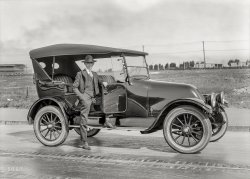
- When in Roamer: 1919
- San Francisco circa 1919. "Roamer touring car at Historical Society (Whittier Mansion)." Our second Roamer in a ... spring eye.
(The Gallery, Cars, Trucks, Buses, Chris Helin, San Francisco) ... Posted by Dave - 12/01/2016 - 8:16pm -
![When in Roamer: 1919 San Francisco circa 1919. "Roamer touring car at Historical Society (Whittier Mansion)." Our second Roamer in a row. 5x7 glass negative. View full size.
Nice WheelsReal hub caps! Out of necessity, the wheel nuts bear against the inside flange and are accessed through the spokes.
Rolls-Royce LookalikeI wonder if anyone was deceived ?
Nice WoodieThe better door is on the house.
Re: HubcapsNope, those 'wheel nuts' are either large rivet heads or carriage bolt heads... at any rate, nothing to be taken off from outside. Presumably the wheels fit on splined shafts and are held on by the central nut.
Houk WheelsThe wheels are likely Houk or possibly Hayes wire wheels. The six rounded protrusions, seen on the center portion, are locating pins that are part of the hub. The wheel is slid onto the hub and matching holes in the center are aligned with these pins. The hub cap, which is, actually, a heavy brass nut, is then securely tightened to hold the wheel on the hub
HMSHis Majesty Serene? Hope Might Stay? Help Me Someone? I wonder what it means?
[Owners often had their initials or monogram placed in that spot. -tterrace]
Ahh! OK.
The hole under rear doorI keep seeing this hole in a lot of late-teen to early '20s cars. What is it for -- lubrication? Some body mounting bolt?
It's a grease-holeThe hole provides access to the grease fitting at the front end of the leaf spring at the rear of the car. You can see a similar one on the exposed front leaf spring eye.
(The Gallery, Cars, Trucks, Buses, Chris Helin, San Francisco)](https://www.shorpy.com/files/images/SHORPY-1062A.thumbnail.jpg)
- Peerless and Poised: 1920
- San Francisco circa 1920. "Peerless touring car." Along with what could be a demonstration of either aerodynamics ... 6½ x 8½ inch glass negative by the prolific Christopher Helin. View full size.
The Benefits of Wealth Those fortunate enough ... Posted by Dave - 11/17/2014 - 3:24pm -
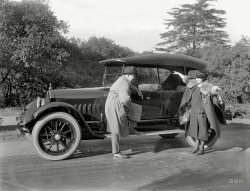
- Mr. Right: 1920
- San Francisco in 1920. "Oldsmobile touring car." Its dapper driver signaling either "hello" or a right turn. 5x7 glass negative by Christopher Helin. View full size.
Fortified Better clues as to location in this ... Posted by Dave - 10/21/2014 - 1:00pm -
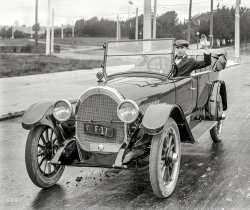
- Rolling Cole: 1925
- ... San Francisco circa 1925. "Cole Aero Eight Series 890 touring car on Gough Street." This was the final year for both the marque and ... glass negative by that automotive amanuensis Christopher Helin. View full size.
The Thin White Line Yet another example of ... Posted by Dave - 07/19/2020 - 3:29pm -
![Rolling Cole: 1925 San Francisco circa 1925. "Cole Aero Eight Series 890 touring car on Gough Street." This was the final year for both the marque and its founder, Joseph J. Cole, who died in August 1925. 5x7 inch glass negative by that automotive amanuensis Christopher Helin. View full size.
The Thin White LineYet another example of body line pinstriping, done by hand. Beautiful.
Be there or be squareI do love a fine automobile but I'll leave the commentary on vintage models -- like this beaut -- to those who know what they're talking about. But being one who is fairly obsessed with shiny windows as well as enamored of geometric shapes (in all honesty I favor circles, but still), I am transfixed by the number of square panes of mosaic-like glass in the windows of the house beyond, belonging to what I imagine must have been a sun room or small conservatory AND in the front. Can you imagine cleaning those? Also I love the way the shades over the larger front windows were pulled to exactly the same place on each window. (Had I lived there, that's exactly as I would have done it.) More squares on the heavy front door as well as its side lights. The symmetry is ever so comforting.
[More of this multifaceted house here and here and here. - Dave]
Wow. Sweet. I remember being taken with the ad copy on the Playboy, so much so that I copied it elsewhere so as not to lose it. Of course I have no idea where I put it so thanks for the reminder.
The retaining wall and bollards surviveVery nice looking car and house. As noted from a previous post -- this spot on Gough Street is now part of Lafayette Park.
Distinctive front and rear tiresi don't believe I have ever seen front and rear specific tires in any vintage photos before. The fronts are grooved for steering control similar to aircraft tires today. the rears are knobby style for traction. Great photo of course.
[Like most cars of the era, this Cole had only rear-wheel brakes. - Dave]
Thank you for closureSometime ago, having seen this house on Shorpy, I set out to find it in vain like a boy in love with a girl from a picture found in a box in the attic. You found her, and she remains no more, except always in my heart.
Aero 8 AdI have had this advertisement hanging on my wall for years. I think mine depicts a 1918 Cole Aero 8.
(The Gallery, Cars, Trucks, Buses, Chris Helin, San Francisco)](https://www.shorpy.com/files/images/SHORPY-1420.thumbnail.jpg)
- Geared to the Road: 1924
- San Francisco circa 1924. "Hudson Super Six touring car at Spreckels Mansion." Plucked from the Shorpy Pantheon of ... Miller Cord tires. 5x7 glass negative by Christopher Helin. View full size.
I don't think ... ... the doors were ... - Dave]
(The Gallery, Cars, Trucks, Buses, Chris Helin, San Francisco) ... Posted by Dave - 05/23/2019 - 2:23pm -
![Geared to the Road: 1924 San Francisco circa 1924. "Hudson Super Six touring car at Spreckels Mansion." Plucked from the Shorpy Pantheon of Pharaonic Phaetons. Our title comes from the slogan on the car's gigantic Miller Cord tires. 5x7 glass negative by Christopher Helin. View full size.
I don't think ... ... the doors were poorly fitted. I think that's the way they were designed to look. Also I don't think that was a single brake light. I think it was just a reflector like they have on bicycles.
[It's a lamp with an electric bulb. - Dave]
MonochromeI'd love to see this colorized. In its present condition, it almost looks like Pershing's spare staff car.
No Okies HereAlthough it was a Hudson Super Six of this vintage that years later purportedly carried the semi-fictional Joads from Oklahoma to California in "The Grapes of Wrath," it is extremely unlikely that theirs featured double-sided whitewalls or full spare wheels (as opposed to merely the demountable rims). Nor was their Hudson likely to have bristled with padlocks like the photo car -- quite an oddity considering that anyone possessing a short length of wire could have made off in minutes with the entire vehicle.
Just for hooligansThe spare tire has a padlock. I didn't know that feature was required then.
We just love rooting through customers' cars looking for the key for the locking lug nuts. In a perfect world, the last people that touched it put it back where it belongs.
Once in a while we will get a car owned by a packrat. Stuff piled to the ceiling, with who knows what living under the pile of magazines and old food. The trunk is usually stuffed too, and the key is buried somewhere in there.
No one really steals alloy wheels anymore so we usually use our special tool to get the locking lug nut off, and install four new lug nuts to match the others.
Give me a brakeCheck out the puny single brake light, placed low where no one will see it.
Several degrees from ElvisThe Spreckels mansion was designed by George A. Applegarth for Adolph B. Spreckels, an heir to the Spreckels Sugar Co. fortune. At 2080 Washington Street, it is currently the home of romance novelist Danielle Steel. Judy Spreckels, the ex-wife of Adolph Jr., became a huge fan of Elvis Presley, traveling and hanging with him and his entourage in LA, Vegas and Memphis.
OdditiesI suppose the padlock on the sidemount spare might have been justified, but it is curious that the one on the external trunk is used not to protect the contents but rather to keep the entire trunk secured to the vehicle. I also had not noticed before the vertical bars between the trunk and the rear of the car body, presumably to prevent movement of the trunk from damaging the body panels.
The other thing that is revealed by the shadows is the shockingly poor fit of the doors, which seem to jut out at the bottom from the body structure itself. Odd on what is otherwise an impressive-looking vehicle.
Trunk or bootI see why we still call that space in the back of our cars a trunk. It was a trunk. So why do the British call it a “boot?” Perhaps someone can enlighten me.
[The boot locker was where your coachman or driver kept his boots. - Dave]
(The Gallery, Cars, Trucks, Buses, Chris Helin, San Francisco)](https://www.shorpy.com/files/images/SHORPY-1389.thumbnail.jpg)
- Neoclassical Gas: 1919
- San Francisco, 1919. "Hudson Biddle & Smart touring limousine at Palace of Fine Arts." Home, Fido! 5x7 glass negative by Christopher Helin. View full size.
Not exactly The 1960s reconstruction of the ... Posted by Dave - 02/09/2017 - 12:14pm -
![Neoclassical Gas: 1919 San Francisco, 1919. "Hudson Biddle & Smart touring limousine at Palace of Fine Arts." Home, Fido! 5x7 glass negative by Christopher Helin. View full size.
Not exactlyThe 1960s reconstruction of the Palace is MOSTLY an exact replica of the 1915 version. The wall of the Palace itself facing the colonnade was originally fully decorated with freestanding and engaged columns identical to those of the colonnade, and the central doors facing the entrance to the rotunda were elaborately framed. This wall was rebuilt smooth, dull and blank (presumably to reduce costs) and its bareness is now screened by trees; the central doors now have minimal moldings framing them. The original concept as executed made the crescent walk behind the colonnade a much richer, more enclosing, visual experience than it is today. A bit of the pergola which crowned the original wall is visible in this photo.
Theft insurance.Love the chain and padlock on the spare tire.
During the big warThe lad on the right has a navy pea coat with chief petty officer rating. Some kids even had a full uniform to wear. Last war that happened.
[He must be standing behind the car. -tterrace]
ReduxThat's the original Palace of Fine Arts Rotunda, built of wood and "staff" (a mixture of plaster and straw) for the Panama-Pacific International Exposition of 1915. Beloved by San Franciscans, it was the only structure retained afterward. The building deteriorated so badly over the next 50 years that it had to be demolished in the fall of 1964. An exact replica was built in its place from permanent materials and was completed two years later.
Early SUVwith integral roof rails and requisite pooch.
FashionistaShe can also be seen here.
Hudson Sold ValueWhen this car was new autos often had mechanical troubles that made them difficult to drive. Hudson was a medium priced car that was both powerful & reliable for its time.
The Super Sixes as shown in this picture were the first production car to feature a counterbalanced crankshaft allowing higher engine speeds, more power & longer life than was typical at the time.
Another feature was a cork clutch which ran in oil that was smooth, long lasting and did not slip. Other types of clutches often jerked, burnt out or slipped. Every Hudson except the first & last years of production was equipped with a cork clutch.
With these mechanical advantages and a moderate price, Hudson sold a lot of Super Sixes and some were fitted with elite bodies such as those by Biddle & Smart.
(The Gallery, Cars, Trucks, Buses, Chris Helin, Dogs)](https://www.shorpy.com/files/images/SHORPY-1086.thumbnail.jpg)
- Urban Alligator: 1921
- San Francisco circa 1921. "Chalmers Six touring car." Fitted with a reptilian custom top. 5x7 glass negative by Christopher Helin. View full size.
New model Maybe it's a Snake Chalmers.
(The Gallery, Cars, Trucks, Buses, Chris Helin, San Francisco) ... Posted by Dave - 08/04/2017 - 11:06am -
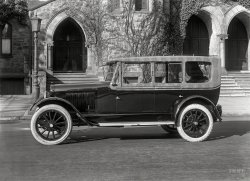
- The H Train: 1919
- 1919. "Cadillac touring car at rail stop." H Line streetcars of the San Francisco Municipal Railway. 5x7 glass negative by Christopher Helin. View full size.
Foot of Van Ness Avenue It took a bit of time ... windshield.
(The Gallery, Cars, Trucks, Buses, Chris Helin, San Francisco, Streetcars) ... Posted by Dave - 10/01/2017 - 8:20pm -
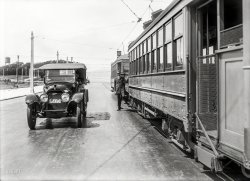
- Sunday Drive: 1920
- San Francisco circa 1920. "Grant touring car." The party last seen here , somewhat rearranged. 5x7 glass negative by Christopher Helin. View full size.
OK, I'll Bite How did they keep their ... gentlemen?
(The Gallery, Cars, Trucks, Buses, Chris Helin, San Francisco) ... Posted by Dave - 09/11/2016 - 5:28pm -
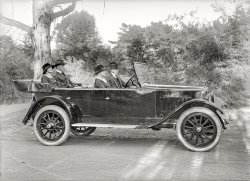
- Franklin Pirate: 1930
- ... San Francisco circa 1930. "Franklin Series 147 'Pirate' Touring Phaeton on Gough Street at Lafayette Park." 5x7 glass negative by Christopher Helin. View full size.
Fun With Maps Curiously, Franklin Street is ... Posted by Dave - 06/10/2018 - 6:15pm -
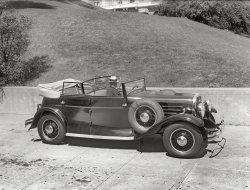
- Sixth Wheel: 1919
- ... just in case."
San Francisco circa 1919. "Mercer touring car at Chain of Lakes, Golden Gate Park." 5x7 glass negative by Christopher Helin. View full size.
No front brakes Braking on the front wheels ... Posted by Dave - 12/14/2016 - 3:33pm -
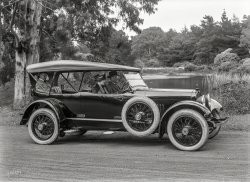
- Salient Six: 1922
- San Francisco, 1922. "Stephens Salient Six touring car." Named after the founder of parent company Moline Plow, Stephens ... around 7,000 cars. 5x7 inch glass negative by Christopher Helin. View full size.
Moline Plow Company I grew up in Moline, ... Posted by Dave - 04/13/2018 - 8:02pm -
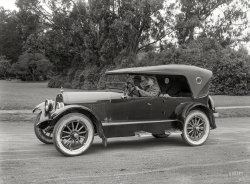
- Two Plus Two: 1920
- San Francisco circa 1920. "Grant touring car." Latest specimen in the Shorpy Bestiary of Bygone Buggies. 5x7 glass plate by Christopher Helin. View full size.
Oh boy - what a group. Can't resist - the ... always near.
(The Gallery, Cars, Trucks, Buses, Chris Helin, San Francisco) ... Posted by Dave - 06/24/2015 - 1:24pm -
![Two Plus Two: 1920 San Francisco circa 1920. "Grant touring car." Latest specimen in the Shorpy Bestiary of Bygone Buggies. 5x7 glass plate by Christopher Helin. View full size.
Oh boy - what a group.Can't resist - the stuffed shirt in the passenger seat is a professor who is a genius at amassing fortunes but a dunce about women. The woman in the back seat with glasses is posing as an intellectual by the name of Miss Magill, and she calls herself Lil, but everyone knows her as Nancy. She is actually an old fashioned gold digger after the professor. Looking closely at the driver, we can see the face of a wise-cracking shyster who has agreed to help Nancy woo the professor into marriage for ten grand and a job as the family chauffeur. The confused looking woman (brought along to make things look on the up-and-up) is thinking; "I thought I was being hired as a nanny, and who are these strange people anyway?'
We'll never make it on time.The Mertz brothers eventually agreed to disagree about the best way to get to Sebastopol. Their wives didn't care, and thought it was a foolish thing to argue about.
Never get there at all!At some point in the series one realizes that every shot is posed and they are not moving at all! Thus the frozen expressions, and the artificial stiff positions, making one wonder just how long an exposure they needed to get these "action" shots?
[Photographic exposures by daylight had been instantaneous for many decades at this point; a fraction of a second. -tterrace]
In the rearThe thing I notice is that the men are sitting in the front and the women in the rear. When my grandparents drove with their contemporaries in the 1950s, it was the same way, although open cars had long disappeared.
Seating ArrangementsYears ago I remember reading an article circa late 50's which said one could determine social status of couples by their seating arrangements.
1. Working Class ... Husband and wives side by side.
2. Middle Class .... Husbands in front and wives in rear.
3. Upper Class ..... Husband A & wife B in front and husband B and wife A in rear.
Since I was and still am in Class 1 I can vouch for the Working Class statement since my lady was always near.
(The Gallery, Cars, Trucks, Buses, Chris Helin, San Francisco)](https://www.shorpy.com/files/images/SHORPY-349-01.thumbnail.jpg)
- Arkansas Travelers: 1920
- San Francisco circa 1920. Three gents in a dusty touring car with Arkansas and Colorado tags (and Yellowstone National Park ... by Crocker-Citizens' Bank in 1967." Photo by Christopher Helin. View full size.
Glass sidewalks We saw a big one here on ... Posted by Dave - 06/03/2015 - 10:36am -
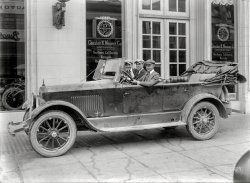
- Cross-Country: 1925
- San Francisco, 1925. "Nash touring car at Nash-Ajax agency." Latest entry in the Shorpy Catalogue of ... thousands.
(The Gallery, Cars, Trucks, Buses, Chris Helin, San Francisco) ... Posted by Dave - 09/30/2015 - 12:08pm -
![Cross-Country: 1925 San Francisco, 1925. "Nash touring car at Nash-Ajax agency." Latest entry in the Shorpy Catalogue of Forgotten Phaetons. 5x7 glass negative. View full size.
In styleCarefree, relaxed and confident: symbols of a world that vanished much too soon. The windshield and the wipers are lovely!
1849 Van Ness Ave.Looks like it still houses old cars; I wonder what the deal is.
[They're classic cars in the Academy of Art University's Automobile Museum. -tterrace]
Phalanx of Phorgotten Phaetons ?Instead of calling this collection the "Catalog of Forgotten Phaetons", how about calling it the "Phalanx of Phorgotten Phaetons???"
Or perhaps the "Phalanx of Photogenic Phaetons" ?
If only there could only be a car which combined all the good features of the old classic and antique cars with the good features of the new cars, like life-saving air bags and crumple zones!
Don't give this guy the highbeamsHalf of this guy's pay must have gone to JC Whitney's.
A Few ObservationsLooks like that driver's side running board wasn't strong enough and needed a a brace of angle iron and a couple of 'C' clamps to remedy.
Someone has great faith in electric starters since they mounted the front license plate in line with the manual start attachment.
And get a good look at those headlights with the clear lenses. I don't recall seeing anything like those on cars of that age before.
I think I've got this figured outOkay, so if I've got this straight, the cars in Frisco are beautiful, but they're really obscure brands and are old-style.
The cars in Oakland are more modern, and some are nice and some are just so-so, and more often than not they are smashed up, especially if they're Oldsmobiles.
Can you guys show me what the cars in, say, San Jose or Mountain View are like?
It's Here! AjaxBeginning in 1925 Nash offered an entry level car called the Ajax. They were built in Racine, Wisconsin, a few miles north of the Nash plant in Kenosha, and sold through the network of Nash agencies. Sales were less than anticipated, so for 1926 it was rebranded as the “Nash Light Six.” Nash, in an effort to protect their Ajax customers, offered them a free conversion kit including “Nash” hubcaps, “Nash” radiator badge, etc., all of which made an old Ajax a Nash in a matter of a hour or so. Attached a picture of Charles W. Nash and his 1925 Ajax.
History of the buildingI believe this is the same building.
Racking: My MemoryThat bracket on the running board holds a folding luggage rack. When I had a 1928 Studebaker Commander Victoria Coupe I was looking for one of those racks. By chance, I found one in a storage area under my very old house. Although I no longer own the car, the luggage rack is still on it.
Night RiderNow that's an automobile! With seven lights (including the parking lights) forward it has a chance against the San Fransico fogs --- if the six volt battery can stand the drain.
Clymer LampThe Nash is equipped with a Clymer spotlight. They were invented by Floyd Clymer, a lifelong automobile enthusiast, motorcycle manufacturer and publisher. The lamp required that a hole be drilled through the windshield. They were very popular and he sold thousands.
(The Gallery, Cars, Trucks, Buses, Chris Helin, San Francisco)](https://www.shorpy.com/files/images/SHORPY-700A.thumbnail.jpg)
- Social Climbers: 1925
- San Francisco circa 1925. "Velie touring car ascending steps." As well as promoting the Philadelphia ... -Dave]
(The Gallery, Cars, Trucks, Buses, Chris Helin, San Francisco) ... Posted by Dave - 04/01/2015 - 5:05pm -
![Social Climbers: 1925 San Francisco circa 1925. "Velie touring car ascending steps." As well as promoting the Philadelphia Sesquicentennial of 1926. 5x7 glass negative. View full size.
Where is it?It's the east front of City Hall.
View Larger Map
Always ascending The ability to climb must have been a big selling point back then.
Made in my home townThe Velie was produced in Moline, Illinois, from 1908 through 1928. Moline is my home town. When I was a kid, I played in Velie Park, about six blocks from my house. Willard Velie was a maternal grandson of John Deere. Deere & Co. is (and was) also based in Moline.
4 wheel hydraulic brakes1925 was the year the Velie first had them. Hard to say if this was a demonstration of how well they worked, or how poorly.
Clearance EnvyWhen with gritted teeth I ease my daily driver over a speed bump or up to a parking lot curb (it's a Dodge Magnum whose front bumper has thrice required replacement) I really miss cars that might have lacked carbon-fiber cup holders and side air bags but could be relied upon not to get too hung up on things.
What are those......weird pants that the guy in the middle is sporting? Some kind of leather inserts which turn into shoe covers which loop under the regular shoes. Is this a set of driving pants? Never saw them before.
[Those are boot spats. -tterrace]
Jodphurs?Our driver is a dashing fellow, but why is he wearing jodphurs to drive a car? Where's the horse?
[Ahem. The word is "jodhpurs." Although what the driver is wearing is canvas gaiters. -Dave]
(The Gallery, Cars, Trucks, Buses, Chris Helin, San Francisco)](https://www.shorpy.com/files/images/SHORPY-299-01.thumbnail.jpg)
- Thoroughly Modern Maxwell: 1919
- San Francisco circa 1919. "Maxwell touring car" is the latest entrant in the Shorpy Festival of Forgotten ... explain it.
(The Gallery, Cars, Trucks, Buses, Chris Helin, San Francisco) ... Posted by Dave - 12/26/2014 - 10:30am -
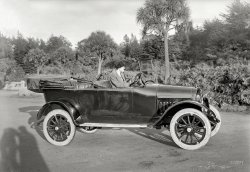
- Tee Party: 1919
- 1919. "Paige touring car at San Francisco Golf Club." Our second look at the "driving" range. 5x7 glass negative by Christopher Helin. View full size.
Are Those Shingles Wood or Slate ? Could ... today.
(The Gallery, Cars, Trucks, Buses, Chris Helin, San Francisco, Sports) ... Posted by Dave - 05/01/2017 - 2:01pm -
![Tee Party: 1919 1919. "Paige touring car at San Francisco Golf Club." Our second look at the "driving" range. 5x7 glass negative by Christopher Helin. View full size.
Are Those Shingles Wood or Slate ?Could those perhaps be slate shingles, rather than wood ?
I've seen slate roofs laid up like that. The ones I've seen were on late 19th or early 20th century buildings which were designed to look "Old World"
Thatch style shinglingA few examples of this type of roofing do in fact still exist in the San Francisco in the Westwood Highlands district of San Francisco. Many English Cottages were built in the 1920's to attract a burgeoning middle class with affordable houses built from scratch. These houses feature cottage roofs, stained glass and other signs of refined decoration. It is one of the most beautiful residential neighborhoods, however obscure the name is compared to better known neighborhoods. It is however in the deep fog prone area, bordered by St. Francis Woods, and during certain heavy fog seasons it is very reminiscent of movies like the Big Sleep.
Can anyone explainthe type of roofing on the building behind?
[Shingles imitating English-cottage thatch. - Dave]
Shingle ArtistryI have seen that pattern of wood roof shingle on cottages of the same era, in Hollywood California. Instead of being cut as rectangles, the wood shingles are cut with one ripple side. When the roofer lays them down, he creates the parallel waves in the way he overlaps the layers.
I have never seen anybody place the ripples as close together as they are on this roof. Maybe these are smaller tiles. The ones in Hollywood were two or three times the distance apart of these rows. But they had a wonderful aesthetic missing from commercial roofs laid today.
Alas, when these homes get re-roofed, nobody re-creates the original look. I saw them back in the 1970s. Doubt any of those roofs, which were 50 years or so old then, survive today.
(The Gallery, Cars, Trucks, Buses, Chris Helin, San Francisco, Sports)](https://www.shorpy.com/files/images/SHORPY-1155.thumbnail.jpg)
- Incognito: 1920
- "San Francisco, 1920. Hudson touring car." Owned by F.W.P., idling in front of the imposing edifice at 1150 ... to the class.
(The Gallery, Cars, Trucks, Buses, Chris Helin, San Francisco) ... Posted by Dave - 02/27/2016 - 11:01pm -
![Incognito: 1920 "San Francisco, 1920. Hudson touring car." Owned by F.W.P., idling in front of the imposing edifice at 1150 Anonymous Avenue. 5x7 glass negative. View full size.
LevitationWhen I first go to this pic it looks like the car lifts about a foot off the pavement. I don't get the same effect when going to full size.
[Stay tiny. - Dave]
Early 3DAt first glance - a delightful sense of this vehicle and its bemused occupant seemingly levitated a few feet above the street. The serendipitous result I'm guessing of the peculiar angle of illumination.
PuzzledWhat is the purpose of the two upright cylinders behind the front bumper? I had hoped that some one else would enquire first but I guess it's up to me to display my automotive ignorance.
[They are Gruss Air Springs, an early shock absorber. - Dave]
F.W.P.Fred W. Pabst was advertising manager of the Don Lee Cadillac franchise, according to the San Francisco City Directory.
There are other F W P listings but whose listed occupations seem unsuitable (molder, detective, chauffeur). I did a thorough search of last names beginning with Pa but gave up when the names changed to Pe. The completion of this proof is left to the class.
(The Gallery, Cars, Trucks, Buses, Chris Helin, San Francisco)](https://www.shorpy.com/files/images/SHORPY-910.thumbnail.jpg)
- The Jackson Six: 1920
- San Francisco circa 1920. "Jackson Six touring car at Golden Gate Park." Named after the Michigan city of its ... and Convertible Torpedo. 5x7 glass negative by Christopher Helin. View full size.
(The Gallery, Cars, Trucks, Buses, Chris Helin, ... Posted by Dave - 05/01/2019 - 8:03pm -
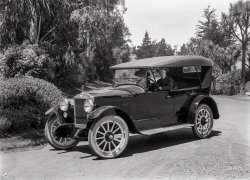
- Six-Park: 1918
- San Francisco, 1918. "Columbia Six touring car." Today's specimen in the Shorpy Menagerie of Mesozoic Motorcars. Photo by Christopher Helin. View full size.
(The Gallery, Cars, Trucks, Buses, Chris Helin, San Francisco) ... Posted by Dave - 07/10/2018 - 1:30am -
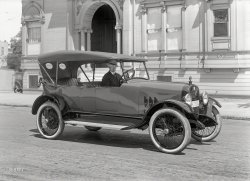
- That Dapper Dort: 1921
- 1921. "Dort touring car at San Francisco Public Library." Waiting for Marian to clock out. 5x7 glass negative by Christopher Helin. View full size.
(The Gallery, Cars, Trucks, Buses, Chris Helin, San Francisco) ... Posted by Dave - 09/24/2016 - 4:03pm -
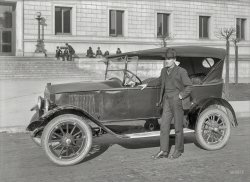
- Go, Gardner, Go: 1922
- San Francisco circa 1922. "Gardner touring car." Latest entry on the Shorpy Manifest of Musty Marques. 5x7 glass negative by Chris Helin. View full size.
(The Gallery, Cars, Trucks, Buses, Chris Helin, San Francisco) ... Posted by Dave - 06/19/2017 - 10:34am -
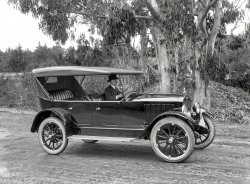
- A Foggy Day: 1919
- San Francisco circa 1919. "Grant Six touring car." The man in back previously seen here . 5x7 glass negative by Christopher Helin. View full size.
(The Gallery, Cars, Trucks, Buses, Chris Helin, San Francisco) ... Posted by Dave - 05/27/2018 - 1:40pm -
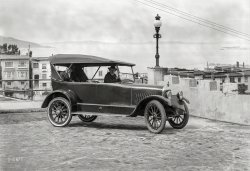
- Sunday Driver: 1923
- ... San Francisco, 1923. "Auburn 'Beauty-Six' Model 6-39 touring car at First Unitarian Church." Today's selection from the Shorpy ... happen by.
(The Gallery, Cars, Trucks, Buses, Chris Helin, San Francisco) ... Posted by Dave - 06/10/2020 - 12:33pm -
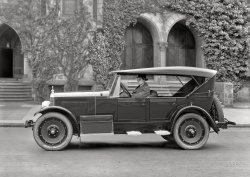
- Dry Roller: 1920
- San Francisco circa 1920. "Chalmers touring car at Spreckels Mansion, N.E. corner Octavia & Washington ... closed-body models. 5x7 inch glass negative by Christopher Helin. View full size.
(The Gallery, Cars, Trucks, Buses, Chris Helin, San Francisco) ... Posted by Dave - 04/09/2017 - 5:32pm -
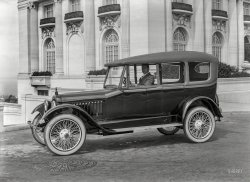
- Culture Club: 1918
- ... San Francisco, 1918. "Buick Model 46 four-passenger touring coupe at de Young Museum, Golden Gate Park." 5x7 glass negative by Chris Helin. View full size.
Into The Club The hood louvers signify that ... Posted by Dave - 06/12/2019 - 12:10pm -
